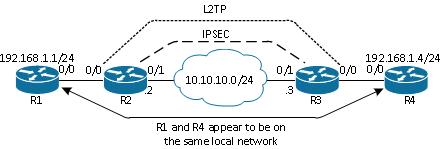基于FlexVPN的L2TPv3配置指南
目录
简介
本文档介绍如何配置第2层隧道协议第3版(L2TPv3)链路,使其在运行Cisco IOS®软件的两台路由器之间通过Cisco IOS FlexVPN虚拟隧道接口(VTI)连接运行。通过此技术,第2层网络可以在一个跨多个第3层跳的IPsec隧道内进行安全扩展,从而允许物理上独立的设备看起来位于同一个本地LAN上。
先决条件
要求
Cisco 建议您了解以下主题:
- Cisco IOS FlexVPN虚拟隧道接口(VTI)
- 第2层隧道协议(L2TP)
使用的组件
本文档中的信息基于以下软件和硬件版本:
- 思科第2代集成多业务路由器(G2),具有安全性和数据许可证。
- 支持FlexVPN的Cisco IOS版本15.1(1)T或更高版本。有关详细信息,请参阅Cisco功能导航器。
此FlexVPN配置使用智能默认和预共享密钥身份验证以简化说明。为了获得最大的安全性,请使用下一代加密;有关详细信息,请参阅下一代加密。
本文档中的信息都是基于特定实验室环境中的设备编写的。本文档中使用的所有设备最初均采用原始(默认)配置。如果您使用的是真实网络,请确保您已经了解所有命令的潜在影响。
配置
网络拓扑
此配置使用此映像中的拓扑。根据安装需要更改IP地址。

路由器 R1
路由器R1的接口上配置了IP地址:
interface Ethernet0/0
ip address 192.168.1.1 255.255.255.0
路由器 R2
FlexVPN
此过程在路由器R2上配置FlexVPN。
- 为对等项创建互联网密钥交换版本2(IKEv2)密钥环:
crypto ikev2 keyring key1
peer 10.10.10.3
address 10.10.10.3
pre-shared-key ciscol - 创建与对等路由器匹配并使用预共享密钥身份验证的IKEv2默认配置文件:
crypto ikev2 profile default
match identity remote address 10.10.10.3 255.255.255.255
identity local address 10.10.10.2
authentication remote pre-share
authentication local pre-share
keyring local key1 - 创建VTI,并使用默认配置文件对其进行保护:
interface Tunnel1
ip address 172.16.1.2 255.255.255.0
tunnel source 10.10.10.2
tunnel destination 10.10.10.3
tunnel protection ipsec profile default
L2TPv3
此过程在路由器R2上配置L2TPv3。
- 创建伪线类以定义封装(L2TPv3),并定义L2TPv3连接用于到达对等路由器的FlexVPN隧道接口:
pseudowire-class l2tp1
encapsulation l2tpv3
ip local interface Tunnel1 - 在相关接口上使用xconnectcommand以配置L2TP隧道;提供隧道接口的对等地址,并指定封装类型:
interface Ethernet0/0
no ip address
xconnect 172.16.1.3 1001 encapsulation l2tpv3 pw-class l2tp1
路由器 R3
FlexVPN
此过程在路由器R3上配置FlexVPN。
- 为对等项创建IKEv2密钥环:
crypto ikev2 keyring key1
peer 10.10.10.2
address 10.10.10.2
pre-shared-key cisco - 创建与对等路由器匹配的IKEv2默认配置文件,并使用预共享密钥身份验证:
crypto ikev2 profile default
match identity remote address 10.10.10.2 255.255.255.255
identity local address 10.10.10.3
authentication remote pre-share
authentication local pre-share
keyring local key1 - 创建VTI,并使用默认配置文件对其进行保护:
interface Tunnel1
ip address 172.16.1.3 255.255.255.0
tunnel source 10.10.10.3
tunnel destination 10.10.10.2
tunnel protection ipsec profile default
L2TPv3
此过程在路由器R3上配置L2TPv3。
- 创建伪线类以定义封装(L2TPv3),并定义L2TPv3连接用于到达对等路由器的FlexVPN隧道接口:
pseudowire-class l2tp1
encapsulation l2tpv3
ip local interface Tunnel1 - 在相关接口上使用xconnectcommand以配置L2TP隧道;提供隧道接口的对等地址,并指定封装类型:
interface Ethernet0/0
no ip address
xconnect 172.16.1.2 1001 encapsulation l2tpv3 pw-class l2tp1
路由器R4
路由器R4的接口上配置了IP地址:
interface Ethernet0/0
ip address 192.168.1.4 255.255.255.0
验证
使用本部分可确认配置能否正常运行。
验证IPsec安全关联
此示例验证是否已在路由器R2上使用接口Tunnel1成功创建了IPsec安全关联。
R2#show crypto sockets
Number of Crypto Socket connections 1
Tu1 Peers (local/remote): 10.10.10.2/10.10.10.3
Local Ident (addr/mask/port/prot): (10.10.10.2/255.255.255.255/0/47)
Remote Ident (addr/mask/port/prot): (10.10.10.3/255.255.255.255/0/47)
IPSec Profile: "default"
Socket State: Open
Client: "TUNNEL SEC" (Client State: Active)
Crypto Sockets in Listen state:
Client: "TUNNEL SEC" Profile: "default" Map-name: "Tunnel1-head-0"
验证IKEv2 SA创建
此示例验证在路由器R2上成功创建了IKEv2安全关联(SA)。
R2#show crypto ikev2 sa
IPv4 Crypto IKEv2 SA
Tunnel-id Local Remote fvrf/ivrf Status
2 10.10.10.2/500 10.10.10.3/500 none/none READY
Encr: AES-CBC, keysize: 256, Hash: SHA512, DH Grp:5, Auth sign: PSK,
Auth verify: PSK
Life/Active Time: 86400/562 sec
IPv6 Crypto IKEv2 SA
验证L2TPv3隧道
此示例验证路由器R2上已正确形成L2TPv3隧道。
R2#show xconnect all
Legend: XC ST=Xconnect State S1=Segment1 State S2=Segment2 State
UP=Up DN=Down AD=Admin Down IA=Inactive
SB=Standby HS=Hot Standby RV=Recovering NH=No Hardware
XC ST Segment 1 S1 Segment 2 S2
------+---------------------------------+--+---------------------------------+--
UP pri ac Et0/0:3(Ethernet) UP l2tp 172.16.1.3:1001 UP
检验R1的网络连通性和外观
此示例检验路由器R1与路由器R4之间是否存在网络连接,并且似乎位于同一个本地网络中。
R1#ping 192.168.1.4
Type escape sequence to abort.
Sending 5, 100-byte ICMP Echos to 192.168.1.4, timeout is 2 seconds:
!!!!!
Success rate is 100 percent (5/5), round-trip min/avg/max = 6/6/6 ms
R1#show arp
Protocol Address Age (min) Hardware Addr Type Interface
Internet 192.168.1.1 - aabb.cc00.0100 ARPA Ethernet0/0
Internet 192.168.1.4 4 aabb.cc00.0400 ARPA Ethernet0/0
R1#show cdp neighbors
Capability Codes: R - Router, T - Trans Bridge, B - Source Route Bridge
S - Switch, H - Host, I - IGMP, r - Repeater, P - Phone,
D - Remote, C - CVTA, M - Two-port Mac Relay
Device ID Local Intrfce Holdtme Capability Platform Port ID
R4 Eth 0/0 142 R B Linux Uni Eth 0/0
故障排除
本节提供可用于对配置进行故障排除的信息:
- debug crypto ikev2 — 启用IKEv2调试。
- debug xconnect event — 启用xconnect事件调试。
- show crypto ikev2 diagnose error — 显示IKEv2退出路径数据库。
命令输出解释程序工具(仅限注册用户)支持某些 show 命令。使用输出解释器工具来查看 show 命令输出的分析。
相关信息
修订历史记录
| 版本 | 发布日期 | 备注 |
|---|---|---|
1.0 |
27-May-2013 |
初始版本 |
 反馈
反馈